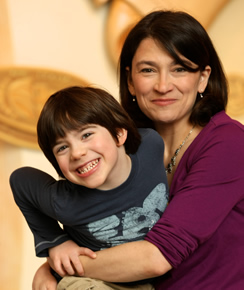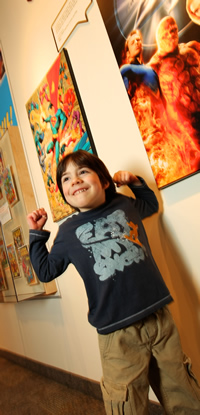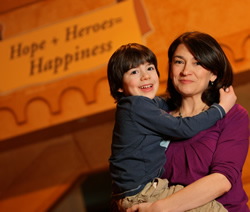Miracle Kids: Addison Koons
Stars Align to Bring Boy Back From the Brink
 It wasn’t unusual for Addison Koons to climb into bed with his mother, Lisa Ashman, in the middle of the night. It happened so often that she would barely wake up. But when he climbed into bed with her at 3 a.m. September 9, 2009, the day he was going to start kindergarten, he didn’t snuggle in like usual.
It wasn’t unusual for Addison Koons to climb into bed with his mother, Lisa Ashman, in the middle of the night. It happened so often that she would barely wake up. But when he climbed into bed with her at 3 a.m. September 9, 2009, the day he was going to start kindergarten, he didn’t snuggle in like usual.
Addison started making a weird noise and his body went rigid. He wouldn’t wake up. Lisa knew something was terribly wrong. Was he having a seizure? She ran to get the phone and called 911. Addison stopped breathing. The dispatcher talked Lisa through CPR (cardiopulmonary resuscitation) while she waited for the first responders.
Within minutes, the Henrietta Fire District, Station 5, arrived and took over CPR. An officer told Lisa to pack a bag while the crew worked on her little boy in an ambulance.
“I ran outside with all my stuff. I was afraid to even look in the ambulance,” Lisa said, recalling that horrific night. “I didn’t know if he was even alive.”
Lt. Mike Kreuzer, and firefighters Kevin Erickson and Joseph Backer Jr. recognized that Addison was in cardiac arrest and used an automated external defibrillator (AED) to shock his heart. A short time later a Henrietta Volunteer Ambulance arrived with paramedics Herbert Dixon and Brian Bartolick and EMTs Alexander Malec and Matthew Jarrett. They intubated Addison and shocked his heart back into a regular rhythm by the time he arrived at Golisano Children's Hospital at the University of Rochester Medical Center.
The trauma room was packed. Lisa couldn’t see her boy past all the people working on him. They kept asking her questions. Did he bump his head? Could he have swallowed any medications? Has he been sick? Lisa couldn’t think of anything that would make Addison go into cardiac arrest. It was surreal. She couldn’t make sense of what was happening.
Then Lisa heard someone in the room say, “Wow, this kid is really strong,” and a little relief and hope washed over her. Maybe Addison was going to make it.
“I figured that if he was responding to them even a little bit…”
 Addison was taken to the pediatric cardiac intensive care unit (PCICU) where he was stabilized, put into a medically induced coma and where they started the hypothermia protocol, in which Addison's body was cooled to 91.5 degrees Fahrenheit. Adult studies have shown that people who have a witnessed cardiac arrest have better neurological outcomes when they are cooled shortly after arrest. Hypothermia slows down the body's metabolism and lessens potential damage to the brain and vital organs caused by the lack of oxygen during cardiac arrest.
Addison was taken to the pediatric cardiac intensive care unit (PCICU) where he was stabilized, put into a medically induced coma and where they started the hypothermia protocol, in which Addison's body was cooled to 91.5 degrees Fahrenheit. Adult studies have shown that people who have a witnessed cardiac arrest have better neurological outcomes when they are cooled shortly after arrest. Hypothermia slows down the body's metabolism and lessens potential damage to the brain and vital organs caused by the lack of oxygen during cardiac arrest.
Karen Powers, M.D., chief of the PCICU, came to Lisa who was anxiously awaiting word on how her boy was doing. Powers told her that Addison was stable and sedated and was on a ventilator.
“He looked so still,” Lisa said. “They were still doing some things, an echocardiogram, and trying to explain to me some things but I wasn’t processing at that point.”
The echocardiogram showed that Addison’s heart was structurally normal, and since the screening tests showing that he hadn’t ingested anything dangerous, all signs pointed to a sudden arrhythmic death syndrome, perhaps Long QT syndrome. Arrhythmias like Long QT can occur spontaneously or with a stimulus, such as exercise or an adrenaline surge.
“This is what AEDs out in the community are meant for,” said Cecilia Meagher, M.D., a pediatric cardiologist at Golisano Children’s Hospital. “Before AEDs were available, many young people with sudden arrhythmias like Addison could die before help arrived.”
Even though Addison’s heart was no longer in an abnormal rhythm, he wasn’t out of the woods yet. Cardiac arrest, in his case, due to a very rapid abnormal heart rhythm, can starve the body of oxygen causing damage to vital organs, such as the brain.
A day after he was cooled all the way down to 91.5 degrees, doctors and nurses started to warm him back up. His organ functions looked good, but they needed to wake him to see if his brain was functioning properly. Before he could even fully wake up, his heart started quivering again. PCICU staff was ready to shock his heart again, but an increase in beta blocker anti-arrhythmia medication got his heart back into a normal rhythm.
The episode told Meagher and the PCICU team that Addison's arrhythmia was behaving more like a rare arrhythmia, Catecholaminergic Polymorphic Ventricular Tachycardia (CPVT). Many pediatric cardiologists might see only one or two cases of CPVT in their entire careers, if at all. Treatment for the arrhythmia includes beta blockers and an internal defibrillator.
The next few days were spent helping Addison's body fight off a minor infection. On Sept. 18, nine days after Addison's cardiac arrest, he was well enough to undergo surgery to implant a defibrillator into his abdomen with electrical leads going into his heart. George Alfieris, M.D., chief of pediatric cardiac surgery, worked with Spencer Rosero, M.D., a URMC cardiologist who specializes in electrophysiology, to implant the defibrillator. If Addison's arrhythmia recurs, the defibrillator will shock his heart back into a regular rhythm.
 Three days after the surgery, PCICU staff again started to wake up Addison while his mother, maternal grandmother and paternal grandmother stood by the bed. He immediately called out to his mother, and even though he hadn't seen his paternal grandmother in 18 months, he recognized her immediately.
Three days after the surgery, PCICU staff again started to wake up Addison while his mother, maternal grandmother and paternal grandmother stood by the bed. He immediately called out to his mother, and even though he hadn't seen his paternal grandmother in 18 months, he recognized her immediately.
“I told him his heart broke but the doctors fixed it and now he has a computer in him, like a superhero,” Lisa said.
Addison has earned his superhero chops. He survived a cardiac arrest many children don't come back from. He underwent a major surgery and now has a sophisticated piece of machinery inside him. He had to rebuild his muscles to walk again. And he had to endure painful dressing changes twice a day for a week.
Although it's apparent soon after meeting Addison that he's a very special boy, his positive, bounding energy belies all this Miracle Kid has been through.